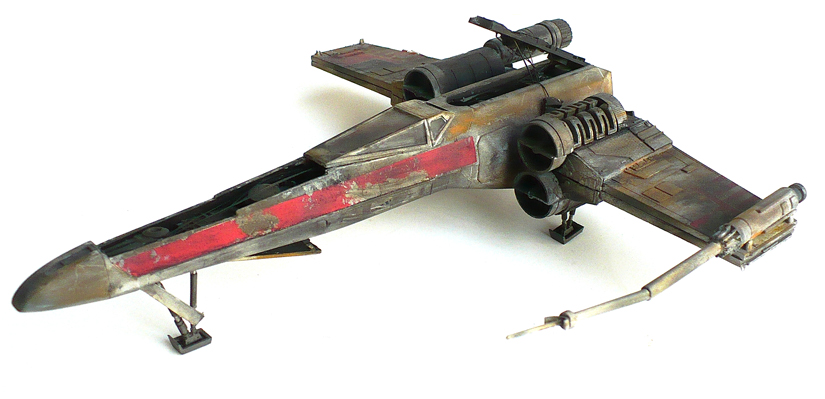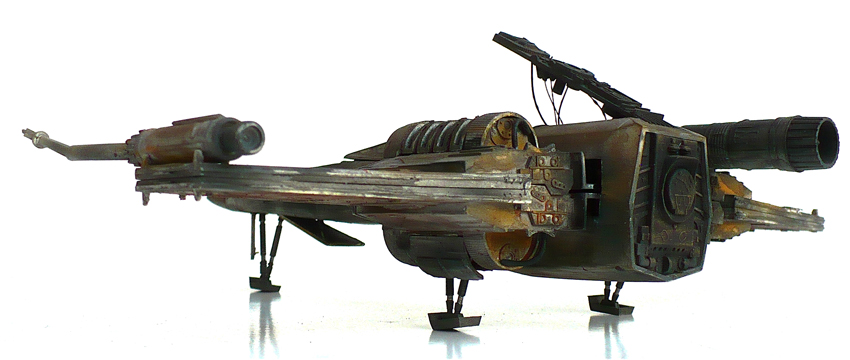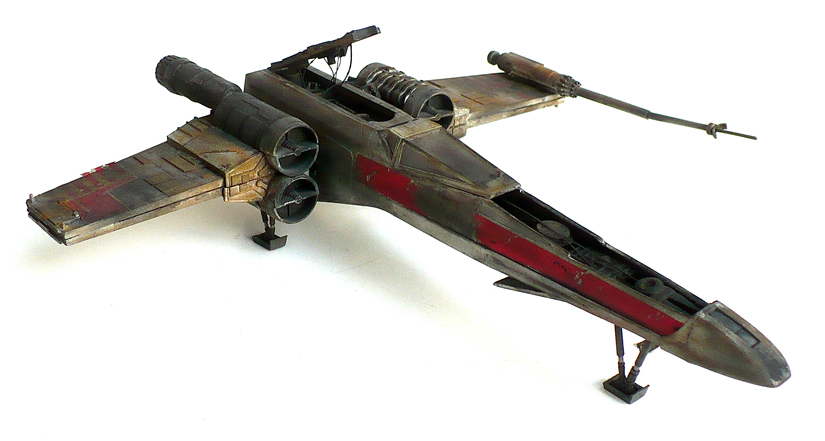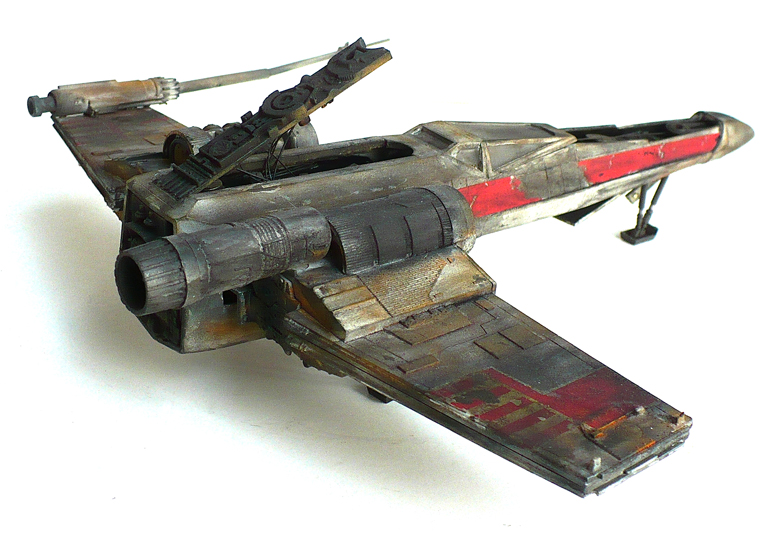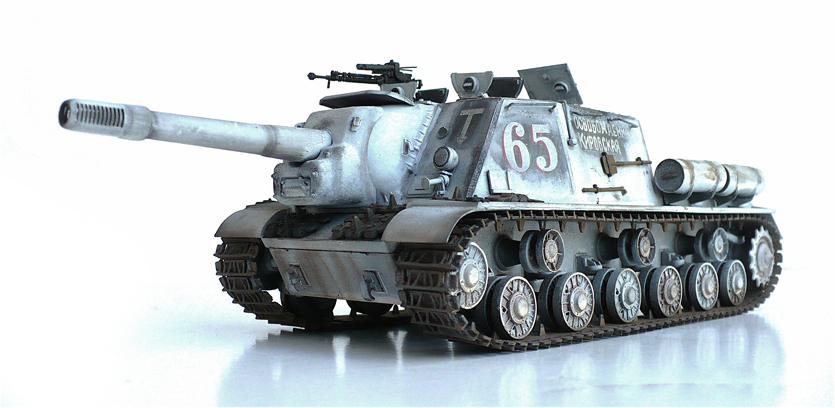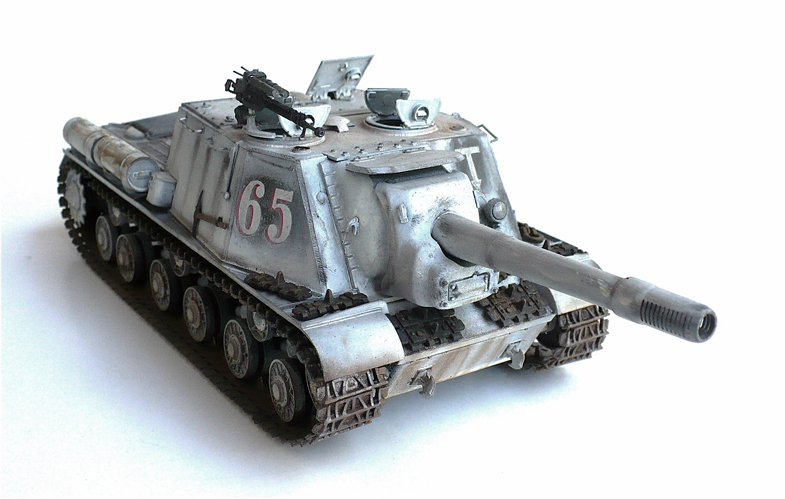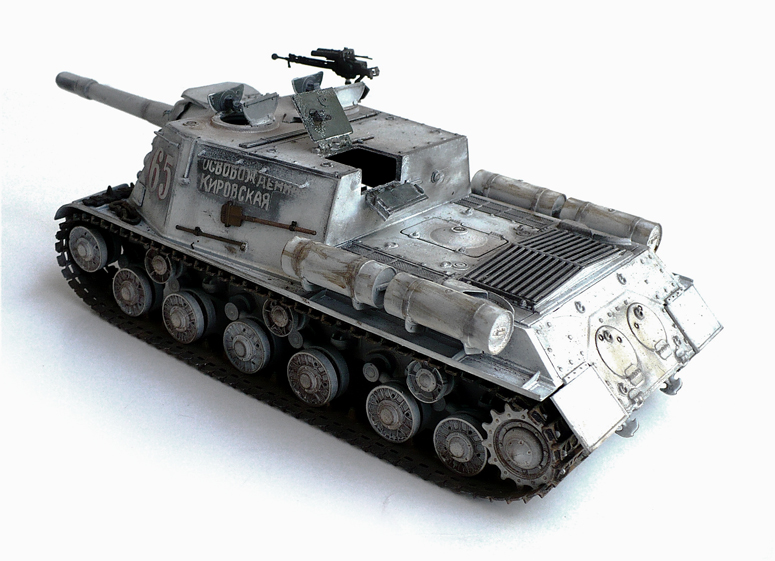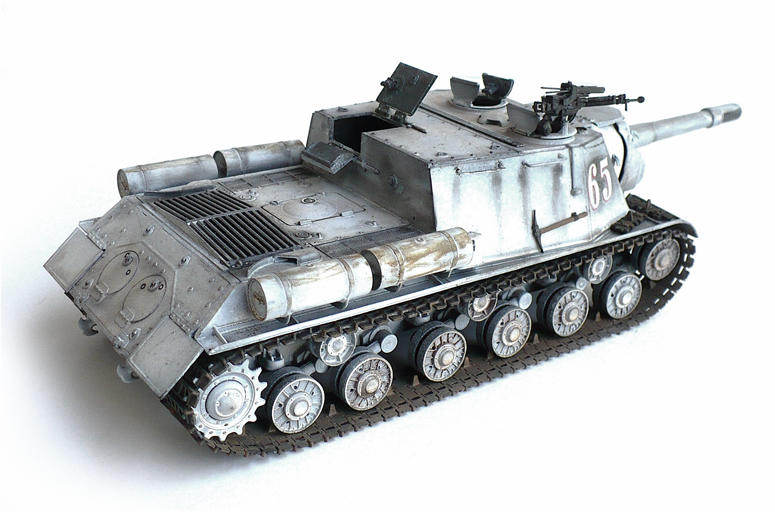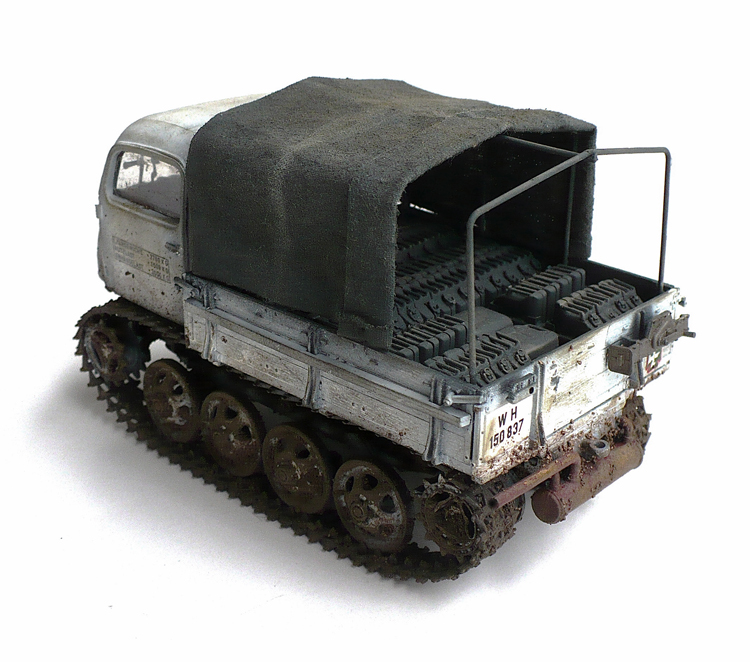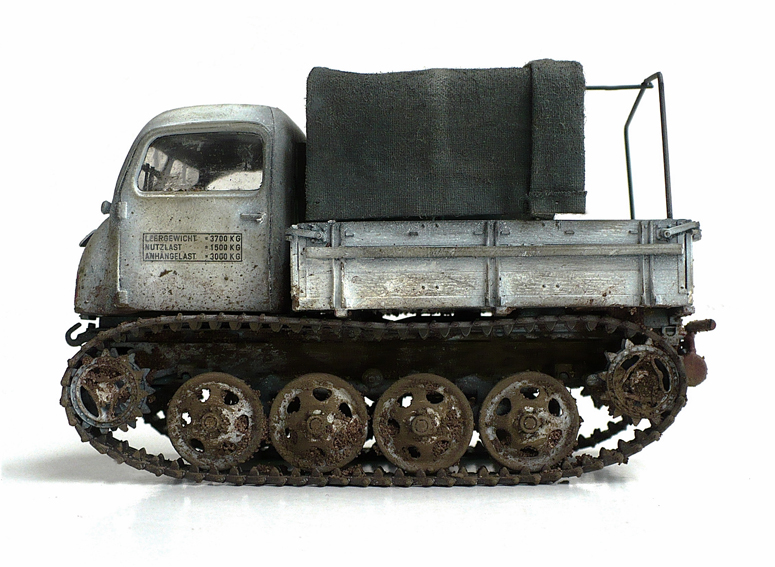During production of The Empire Strikes Back, designer Joe Johnston conceived a ship that combined the body of an X-wing and the cockpit of the Y-wing.
However, this design was scrapped for the T-47, which featured no
elements from previous craft. Johnston's designs for the Snowspeeders
have influenced later Star Wars designers, such as Tommy Lee Edwards.
The
models were built in three different scales by Steve Gawley, Charlie
Bailey, and Mike Fulmer of ILM, with the smallest (20 inches) used for
motion control photography, and the largest (2½ feet) for hero and
pyrotechnic shots. All
models included motor-controlled flaps to imply maneuverability, and
the largest version also possessed motor-articulated crew. Several full-scale props were built in London for the hangar, cockpit, and speeder crash scenes.
Translate
Wednesday, July 30, 2014
Snowspeeder
Here are some more images of AMTs 1/35 scale Snowspeeder from Star Wars the Empire Strikes Back. From Wikipedia "A snowspeeder is a Rebel Alliance vehicle featured in Star Wars Episode V: The Empire Strikes Back (1980) and several books, comics, and video games in the Star Wars Expanded Universe. Snowspeeder models and replicas have been merchandised by several companies.
Monday, July 28, 2014
TIE Advanced X1 Fighter
Here are some more images of
AMT/ERTL 1/36 scale Darth Vader's TIE Advanced X1 Fighter. From
Wookieepedia, that's right Wookieepedia "
The TIE Advanced x1, or TIE/x1 was an advanced prototype starfighter touted as a replacement for the standard TIE Fighter and tested by Darth Vader at the Battle of Yavin and used by X1 during the Battle of Mustafar. At one point, the clone of Galen Marek stole Darth Vader's TIE Advanced x1 to escape Kamino.
While it never made it into production, many of its best design features were later incorporated into the TIE/sa bomber and TIE/In interceptor. Further development of the Advanced continued, eventually leading to the TIE Avenger and TIE Defender.
The TIE Advanced x1 featured a solar ionization reactor and paired twin ion engines like the original TIE Fighter.
However, the x1 had an original spaceframe, with an elongated rear
deck and reinforced durasteel-alloy hull. The x1's most important
innovation was its "bent-wing" solar array wings, which had the
advantages of increased surface area for more power while also reducing
the craft's profile, compared to the TIE/ln starfighter's hexagonal
panel wings.
Speed was only slightly improved due to the added mass of the vessel; a good deal of the extra power was bled off to the deflector shield generators. While less maneuverable than standard TIE fighters, it was more resilient in battle.
The TIE Advanced x1 had twin heavy blaster cannons in a fixed, front-mounted position, as well as a cluster missile launcher. In addition to its shields, it had a modest hyperdrive but no life-support systems.
The target tracking system was also more sophisticated than the
already formidable advanced targeting system on standard TIE craft,
used to overcome the extremely powerful electronic jamming used by all
combat craft to defeat target lock in battle. For best performance, the
targeting system of the x1 required frequent adjustment in combat.
Sunday, July 27, 2014
Abandoned Parts Queen X Wing
Here are some more images of my 1/48 scale Abandoned Parts Queen X Wing Starfighter. This model was built from MPC's 1/48 scale X Wing.
The interiors were built from parts from my spares box.
The interiors were built from parts from my spares box.
Darth Vader
Here are some more images of MPC's 1/8 scale Darth Vader from the Star Wars franchise.
From Wikipedia"
Darth Vader (born Anakin Skywalker) is a fictional character in the Star Wars universe. He appears in the original trilogy, as well as the prequel trilogy.
The character was created by George Lucas and has been portrayed by numerous actors. His appearances span all six Star Wars films, and he is an important character in the expanded universe of television series, video games, novels, literature and comic books. Originally a Jedi prophesied to bring balance to the Force, he falls to the dark side of the Force and serves the evil Galactic Empire at the right hand of his Sith master, Darth Sidious. He is also the father of Luke Skywalker and Princess Leia Organa.
The American Film Institute listed him as the third greatest movie villain in cinema history on 100 Years... 100 Heroes and Villains, behind Hannibal Lecter and Norman Bates.
In the first draft of The Star Wars, tall, grim general "Darth Vader" came closer in line with his final depiction in the second revision, and the protagonist "Anikin Starkiller" had a role similar to Luke Skywalker's as the 16-year-old son of a respected warrior. Vader's mask was originally designed by Ralph McQuarrie as part of Vader's spacesuit and not intended to be part of the regular costume. Brian Muir sculpted Vader's costume based on McQuarrie's design.
After the success of Star Wars, Lucas hired science fiction author Leigh Brackett to write Star Wars II with him. They held story conferences and, by late November 1977, Lucas had produced a handwritten treatment. The treatment is very similar to the final film, except that Vader does not reveal he is Luke's father. In the first draft that Brackett would write from this, Luke's father appears as a ghost to instruct Luke. Lucas was disappointed with the script, but Brackett died of cancer before he could discuss it with her. With no writer available, Lucas had to write the next draft himself. In this draft, he made use of a new plot twist: Vader claiming to be Luke's father. According to Lucas, he found this draft enjoyable to write, as opposed to the year-long struggles writing the first film.
The new plot element of Luke's parentage had drastic effects on the series. Michael Kaminski argues in his book that it is unlikely that the plot point had ever seriously been considered or even conceived of before 1978, and that the first film was clearly operating under an alternate storyline where Vader was a separate character from Luke's father; there is not a single reference to this plot point before 1978 as Obi-Wan Kenobi referred to him as "Darth" as if it is his true name rather than the Sith title. After writing the second and third drafts in which the point was introduced, Lucas reviewed the new backstory he had created: Anakin had been Obi-Wan's brilliant student and had a child named Luke, but was swayed to the dark side by Palpatine. Anakin battled Kenobi on the site of a volcano and was badly wounded, but was then reborn as Vader. Meanwhile, Kenobi hid Luke on Tatooine while the Galactic Republic became the tyrannical Galactic Empire and Vader systematically hunted down and killed the Jedi. This change in character would provide a springboard to the "Tragedy of Darth Vader" storyline that underlies the prequels.
After deciding to create the prequels, Lucas indicated the series would be a tragic one depicting Anakin's fall to the dark side. He also saw that the prequels could form the beginning of one long story that started with Anakin's childhood and ended with his death. This was the final step towards turning the film series into a "Saga".
For the first prequel, Lucas made Anakin nine years old to make the character's separation from his mother more poignant. Movie trailers focused on Anakin and a one-sheet poster showing him casting Vader's shadow informed otherwise unknowing audiences of the character's eventual fate. The movie ultimately achieved a primary goal of introducing audiences to Anakin.
Michael Kaminski, in The Secret History of Star Wars, offers evidence that issues in Anakin's fall to the dark side prompted Lucas to make massive story changes, first revising the opening sequence of the third prequel to have Palpatine kidnapped and his apprentice murdered by Anakin as the first act in the latter's turn towards the dark side. After principal photography was complete in 2003, Lucas made even more massive changes in Anakin's character, re-writing his entire turn to the dark side; his fall from grace would now be motivated by a desire to save Padmé Amidala rather than the previous version in which that reason was one of several, including that he genuinely believed that the Jedi were plotting to take over the Republic. This fundamental re-write was accomplished both through editing the principal footage, and new and revised scenes filmed during pick-ups in 2004.
In Attack of the Clones, Anakin Skywalker feels "smothered" by Obi-Wan Kenobi and is unable to control his life. By Revenge of the Sith, however, his "father-son" friction with his master has matured into a more equal, brotherly relationship. Once he becomes Darth Vader, each evil act he commits makes it harder for him to return to the light, but ultimately escapes the dark side and redeems himself before he dies by saving his son Luke Skywalker and killing Palpatine in Return of the Jedi.
Eric Bui, a psychiatrist at University of Toulouse Hospital, argued at the 2007 American Psychiatric Association convention that Anakin meets six of the nine diagnostic criteria for borderline personality disorder (BPD), one more than necessary for a diagnosis. He and a colleague, Rachel Rodgers, published their findings in a 2010 letter to the editor of the journal Psychiatry Research. Bui says he found Anakin Skywalker a useful example to explain BPD to medical students. In particular, Bui points to Anakin's abandonment issues and uncertainty over his identity. Anakin's mass murders of the Tusken Raiders in Attack of the Clones and the young Jedi in Revenge of the Sith count as two dissociative episodes, fulfilling another criterion. Bui hoped his paper would help raise awareness of the disorder, especially among teens.
From Wikipedia"
Darth Vader (born Anakin Skywalker) is a fictional character in the Star Wars universe. He appears in the original trilogy, as well as the prequel trilogy.
The character was created by George Lucas and has been portrayed by numerous actors. His appearances span all six Star Wars films, and he is an important character in the expanded universe of television series, video games, novels, literature and comic books. Originally a Jedi prophesied to bring balance to the Force, he falls to the dark side of the Force and serves the evil Galactic Empire at the right hand of his Sith master, Darth Sidious. He is also the father of Luke Skywalker and Princess Leia Organa.
The American Film Institute listed him as the third greatest movie villain in cinema history on 100 Years... 100 Heroes and Villains, behind Hannibal Lecter and Norman Bates.
In the first draft of The Star Wars, tall, grim general "Darth Vader" came closer in line with his final depiction in the second revision, and the protagonist "Anikin Starkiller" had a role similar to Luke Skywalker's as the 16-year-old son of a respected warrior. Vader's mask was originally designed by Ralph McQuarrie as part of Vader's spacesuit and not intended to be part of the regular costume. Brian Muir sculpted Vader's costume based on McQuarrie's design.
After the success of Star Wars, Lucas hired science fiction author Leigh Brackett to write Star Wars II with him. They held story conferences and, by late November 1977, Lucas had produced a handwritten treatment. The treatment is very similar to the final film, except that Vader does not reveal he is Luke's father. In the first draft that Brackett would write from this, Luke's father appears as a ghost to instruct Luke. Lucas was disappointed with the script, but Brackett died of cancer before he could discuss it with her. With no writer available, Lucas had to write the next draft himself. In this draft, he made use of a new plot twist: Vader claiming to be Luke's father. According to Lucas, he found this draft enjoyable to write, as opposed to the year-long struggles writing the first film.
The new plot element of Luke's parentage had drastic effects on the series. Michael Kaminski argues in his book that it is unlikely that the plot point had ever seriously been considered or even conceived of before 1978, and that the first film was clearly operating under an alternate storyline where Vader was a separate character from Luke's father; there is not a single reference to this plot point before 1978 as Obi-Wan Kenobi referred to him as "Darth" as if it is his true name rather than the Sith title. After writing the second and third drafts in which the point was introduced, Lucas reviewed the new backstory he had created: Anakin had been Obi-Wan's brilliant student and had a child named Luke, but was swayed to the dark side by Palpatine. Anakin battled Kenobi on the site of a volcano and was badly wounded, but was then reborn as Vader. Meanwhile, Kenobi hid Luke on Tatooine while the Galactic Republic became the tyrannical Galactic Empire and Vader systematically hunted down and killed the Jedi. This change in character would provide a springboard to the "Tragedy of Darth Vader" storyline that underlies the prequels.
After deciding to create the prequels, Lucas indicated the series would be a tragic one depicting Anakin's fall to the dark side. He also saw that the prequels could form the beginning of one long story that started with Anakin's childhood and ended with his death. This was the final step towards turning the film series into a "Saga".
For the first prequel, Lucas made Anakin nine years old to make the character's separation from his mother more poignant. Movie trailers focused on Anakin and a one-sheet poster showing him casting Vader's shadow informed otherwise unknowing audiences of the character's eventual fate. The movie ultimately achieved a primary goal of introducing audiences to Anakin.
Michael Kaminski, in The Secret History of Star Wars, offers evidence that issues in Anakin's fall to the dark side prompted Lucas to make massive story changes, first revising the opening sequence of the third prequel to have Palpatine kidnapped and his apprentice murdered by Anakin as the first act in the latter's turn towards the dark side. After principal photography was complete in 2003, Lucas made even more massive changes in Anakin's character, re-writing his entire turn to the dark side; his fall from grace would now be motivated by a desire to save Padmé Amidala rather than the previous version in which that reason was one of several, including that he genuinely believed that the Jedi were plotting to take over the Republic. This fundamental re-write was accomplished both through editing the principal footage, and new and revised scenes filmed during pick-ups in 2004.
Darth Vader was portrayed by bodybuilder David Prowse, stunt performer Bob Anderson performed the character's intense lightsaber fight scenes, and James Earl Jones provided the voice but was initially uncredited in A New Hope and The Empire Strikes Back because he felt his contributions were too small to warrant recognition. The character has also been voiced by Scott Lawrence and Matt Sloan for several video games.
Anakin Skywalker has been portrayed by Sebastian Shaw in Return of the Jedi, Jake Lloyd in The Phantom Menace, and Hayden Christensen in Attack of the Clones and Revenge of the Sith and appears briefly reprising the role in the final scene of Return of the Jedi. The character has also been voiced by Mat Lucas for the 2003 micro-series and Matt Lanter in the CGI 2008 film and later animated TV series.In Attack of the Clones, Anakin Skywalker feels "smothered" by Obi-Wan Kenobi and is unable to control his life. By Revenge of the Sith, however, his "father-son" friction with his master has matured into a more equal, brotherly relationship. Once he becomes Darth Vader, each evil act he commits makes it harder for him to return to the light, but ultimately escapes the dark side and redeems himself before he dies by saving his son Luke Skywalker and killing Palpatine in Return of the Jedi.
Eric Bui, a psychiatrist at University of Toulouse Hospital, argued at the 2007 American Psychiatric Association convention that Anakin meets six of the nine diagnostic criteria for borderline personality disorder (BPD), one more than necessary for a diagnosis. He and a colleague, Rachel Rodgers, published their findings in a 2010 letter to the editor of the journal Psychiatry Research. Bui says he found Anakin Skywalker a useful example to explain BPD to medical students. In particular, Bui points to Anakin's abandonment issues and uncertainty over his identity. Anakin's mass murders of the Tusken Raiders in Attack of the Clones and the young Jedi in Revenge of the Sith count as two dissociative episodes, fulfilling another criterion. Bui hoped his paper would help raise awareness of the disorder, especially among teens.
Saturday, July 26, 2014
M-48 A-2 Patton Tank
Here are some images of Monograms 1/32 scale M-48 A-2 Patton Tank.
From Wikipedia"
The M48 Patton is a main battle tank that was designed in the United States. It was the third tank to be officially named after General George S. Patton, commander of the U.S. Third Army during World War II and one of the earliest American advocates for the use of tanks in battle It was a further development of the M47 Patton tank. The M48 Patton was in U.S. service until replaced by the M60. The M48 served as the U.S. Army and Marine Corps's primary battle tank during the Vietnam War. It was widely used by U.S. Cold War allies, especially other NATO countries.
The M48 Patton tank was designed to replace the previous M47 Pattons and M4 Shermans. Although largely resembling the M47, the M48 Patton was a completely new tank design. Some M48A5 models served well into the 1980s with American forces, and many various M48 Patton models remain in service in other countries. The M48 was the last U.S. tank to mount the 90 mm tank gun, with the last model, the M48A5, being upgraded to carry the new standard weapon of the M60, the 105mm gun.
The Turkish Army has the largest number of modernized M48 MBTs, with more than 1,400 M48s in its inventory. Of these, around 1,000 have been phased out or are in storage, or have been modified to ARVs.
On 27 February 1951, OTCM #33791 initiated the design of the new tank, designated the 90mm Gun Tank T-48 (the prefix letter "T" would be replaced by the prefix "X" beginning with the M60 series tank). A deeper modernization than the M46 and the M47, the M48 featured a new hemispherical turret, new redesigned hull, and an improved suspension. The hull machine gunner position was removed, reducing the crew to 4. It was essentially a new tank. On 2 April 1953, the Ordnance Technical Committee Minutes (OTCM) order #34765 standardized the last of the Patton series tanks as the 90mm Gun Tank M48 Patton.
Nearly 12,000 M48s were built from 1952 to 1959. The early designs, up to the M48A2C's, were powered by a gasoline 12-cylinder engine which was coupled with an auxiliary 8-cylinder engine (called the "Little Joe"). The gasoline engine gave the tank a short operating range and were prone to catching fire when hit. This version was considered unreliable but numerous examples saw combat use in various Arab-Israeli conflicts. They also were prone to fire when the turret was penetrated and the hydraulic lines ruptured spewing hydraulic fluid (nicknamed "cherry juice" because of its red color) at high pressure into the crew compartment resulting in a fireball. The flashpoint was too low, less than 300 °F (150 °C), causing many burns and deaths to crew members. Beginning in 1959, most American M48s were upgraded to the M48A3 model which featured a diesel power plant. M48s with gasoline engines, however, were still in use in the US Army through 1968 and through 1975 by many West German Army units including the 124th Panzer Battalion.
From Wikipedia"
The M48 Patton is a main battle tank that was designed in the United States. It was the third tank to be officially named after General George S. Patton, commander of the U.S. Third Army during World War II and one of the earliest American advocates for the use of tanks in battle It was a further development of the M47 Patton tank. The M48 Patton was in U.S. service until replaced by the M60. The M48 served as the U.S. Army and Marine Corps's primary battle tank during the Vietnam War. It was widely used by U.S. Cold War allies, especially other NATO countries.
The M48 Patton tank was designed to replace the previous M47 Pattons and M4 Shermans. Although largely resembling the M47, the M48 Patton was a completely new tank design. Some M48A5 models served well into the 1980s with American forces, and many various M48 Patton models remain in service in other countries. The M48 was the last U.S. tank to mount the 90 mm tank gun, with the last model, the M48A5, being upgraded to carry the new standard weapon of the M60, the 105mm gun.
The Turkish Army has the largest number of modernized M48 MBTs, with more than 1,400 M48s in its inventory. Of these, around 1,000 have been phased out or are in storage, or have been modified to ARVs.
On 27 February 1951, OTCM #33791 initiated the design of the new tank, designated the 90mm Gun Tank T-48 (the prefix letter "T" would be replaced by the prefix "X" beginning with the M60 series tank). A deeper modernization than the M46 and the M47, the M48 featured a new hemispherical turret, new redesigned hull, and an improved suspension. The hull machine gunner position was removed, reducing the crew to 4. It was essentially a new tank. On 2 April 1953, the Ordnance Technical Committee Minutes (OTCM) order #34765 standardized the last of the Patton series tanks as the 90mm Gun Tank M48 Patton.
Nearly 12,000 M48s were built from 1952 to 1959. The early designs, up to the M48A2C's, were powered by a gasoline 12-cylinder engine which was coupled with an auxiliary 8-cylinder engine (called the "Little Joe"). The gasoline engine gave the tank a short operating range and were prone to catching fire when hit. This version was considered unreliable but numerous examples saw combat use in various Arab-Israeli conflicts. They also were prone to fire when the turret was penetrated and the hydraulic lines ruptured spewing hydraulic fluid (nicknamed "cherry juice" because of its red color) at high pressure into the crew compartment resulting in a fireball. The flashpoint was too low, less than 300 °F (150 °C), causing many burns and deaths to crew members. Beginning in 1959, most American M48s were upgraded to the M48A3 model which featured a diesel power plant. M48s with gasoline engines, however, were still in use in the US Army through 1968 and through 1975 by many West German Army units including the 124th Panzer Battalion.
Panzer Jager 38t Marder III
Here are some more images of Italeri's 1/35 scale Panzer Jager 38t Marder III.
From Wikipedia"
The Marder III is the name for a series of World War II German tank destroyers built on the chassis of the Panzer 38(t). The German word Marder means "marten" in English. They were in production from 1942 to 1944 and served on all fronts until the end of the war.
Even in the early stages of Operation Barbarossa, the Wehrmacht already felt the need for a more mobile and more powerful anti-tank solution than the existing towed anti-tank guns such as Pak 36 or tank destroyers like the Panzerjäger I. This need became urgent in 1942, when anti-tank shells failed to penetrate the armour of new Soviet tanks like the T-34 and KV-1.
As an interim solution, it was decided to use captured French vehicles like the Lorraine (Marder I), obsolete tanks such as German Panzer II (Marder II), and Czech-supplied Panzer 38(t) (Marder III) as the base for makeshift tank destroyers. The result was the Marder series, which were armed with either captured Soviet 76.2mm F-22 Model 1936 divisional field guns, or German 7.5 cm PaK 40 anti-tank guns for later versions. Due to weight and space constraints of these small chassis, Marder series were not fully armored. Thin upper armor protection was provided only for the front and sides against shrapnel and small arms only. All Marder series had open tops. Some were issued with canvas tops to protect the crew from the elements. In this regard, Marder was more of a gun carriage than a proper Panzerjäger that could exchange shells with enemy tanks.
While the Panzer 38(t) had largely become obsolete as a tank in early 1942, it was still an excellent platform for adaptation into a tank destroyer, among other roles. Since the Soviet 76.2 mm field gun was captured in large quantities, the decision was made to mate this gun to the Panzer 38(t).
To do so, the production of the Panzer 38(t) Ausf. G was stopped and a modified superstructure was bolted onto the standard tank chassis. The upper structure mounted the gun and an extended gun shield, giving very limited protection for the commander and the loader. Armour protection overall ranged from 10 to 50 mm with no armor at all above and behind the gun compartment. The gun, commander and loader were located on top of the engine deck. It had a higher silhouette than the original Panzer 38 (t), which made it more vulnerable to enemy fire.
The now-called 7.62 cm PaK 36(r) was rechambered to be able to use standard German 75 mm ammunition, of which 30 rounds could be carried inside the vehicle. Apart from the main gun, there was a 7.92 mm machine gun mounted in the hull.
This tank destroyer was put into production as the Panzerjäger 38(t) für 7.62 cm PaK 36(r), Sd.Kfz. 139. A total of 344 vehicles were built in three series from April to November 1942. Chassis numbers were 1360-1479, 1527-1600 and 1601-1750.
The next variant of the Marder III fielded the standard 7.5 cm PaK 40 German anti-tank gun on a slightly modified Panzer 38(t) Ausf. H chassis. This chassis had the engine still in the rear of the vehicle but, unlike the previous model, this vehicle utilized the fighting compartment of Panzer 38 in the center. Center compartment allowed crew to stay low in the center of the vehicle, lowering crew exposure to small arms fire and fragments. But because of the rear-mounted engine, there was only enough room for two men to stand in the center. Large side armors gave additional protection for the crew. However, the horseshoe shape armor thinly protected front and side only. The rear and the top were exposed. Thirty-eight rounds of ammunition for the gun were carried. As with the Sd.Kfz.139, this vehicle also carried a 7.92 mm machine gun in the hull, of Czech manufacture.
The full name of the Ausf. H was the 7.5 cm PaK 40/3 auf Panzerkampfwagen 38(t) Ausf. H, Sd.Kfz. 138. a total of 275 vehicles were built in two series from November 1942 to April 1943. An additional 175 vehicles were converted from Panzer 38(t)'s in 1943. Chassis numbers of new vehicles were 1751–2075 and 2121–2147 (overlapping with simultaneous Grille production).
The last Marder III variant was based on the Geschützwagen 38(t) Ausf. M, a purpose-designed vehicle for self-propelled gun usage, again armed with the 75 mm PaK 40 anti-tank gun. Ausf. M was the final variant of the Marder series and was a significant improvement over previous models, with its lower silhouette, sloped armour and much more functional fighting compartment. In this variant, the engine was moved from the rear to the middle between driver and the rest of the crew. Because there was no engine in the rear, the gun and the crew did not have to sit on top of the engine deck as in previous models. The fighting compartment could be lowered down to the bottom floor level where the engine used to be. This decreased crew exposure, as well as visibility. Unlike the previous two Marder IIIs, the fighting compartment was closed at the rear protecting the crew up to their midsection. It stayed open-topped. It could only carry 27 rounds of ammunition. The machinegun port at the front was eliminated in the Ausf. M in favor of an MG 34 or MG 42 carried by the crew. In the previous two models, the commander served as a gunner. However, in Ausf. M, the radio man moved to the rear with the commander and gunner, serving as a loader. Combat effectiveness increased because the vehicle commander was freed from manning the gun.
The full name of the Ausf. M was Panzerjäger 38(t) mit 7.5 cm PaK 40/3 Ausf. M, Sd.Kfz. 138 . It was the variant which was produced in the largest numbers, in total 942 vehicles were built in two series from May 1943 to May 1944. Chassis numbers were 2166–2600 and 2601–3600 (overlapping with simultaneous Grille and Flakpanzer 38(t) production).
The various Marder IIIs fought on all fronts of the war, with the Sd. Kfz. 139 being used mainly at the Eastern Front, though some also fought in Tunisia. In February 1945 some 350 Ausf. M were still in service.
The Marder IIIs were used by the Panzerjäger Abteilungen of the Panzer divisions of both the Wehrmacht and the Waffen SS, as well as several Luftwaffe units, like the Hermann Göring division.
The Marder IIIs were mechanically reliable, as with all vehicles based on the Czechoslovak LT-38 chassis. Their firepower was sufficient to destroy the majority of Soviet tanks on the battlefield at combat range.
The Marder' IIIs weaknesses were mainly related to survivability. The combination of a high silhouette and open-top armor protection made them vulnerable to indirect artillery fire. The armor was also quite thin, making them highly vulnerable to enemy tanks and to close-range machinegun fire.
The Marders were not assault vehicles or tank substitutes; the open top meant that operations in urban areas or other close-combat situations were very risky. They were best employed in defensive or overwatch roles. Despite their mobility they did not replace the towed antitank guns.
In March 1942, before Marder III appeared, Germany already started production of StuG III assault gun with comparable anti-tank capability (StuG III Ausf. F and later variants). These were fully armored vehicles, built in much greater numbers than vulnerable Marder III. Among many German fully armored tank destroyers, also one based on Panzer 38(t) chassis was built in numbers since 1944: the Jagdpanzer 38(t). The weakly armored Marder series were phased out of production in favor of the Jagdpanzer 38(t) but Marder series vehicles served until the end of the conflict.
From Wikipedia"
The Marder III is the name for a series of World War II German tank destroyers built on the chassis of the Panzer 38(t). The German word Marder means "marten" in English. They were in production from 1942 to 1944 and served on all fronts until the end of the war.
Even in the early stages of Operation Barbarossa, the Wehrmacht already felt the need for a more mobile and more powerful anti-tank solution than the existing towed anti-tank guns such as Pak 36 or tank destroyers like the Panzerjäger I. This need became urgent in 1942, when anti-tank shells failed to penetrate the armour of new Soviet tanks like the T-34 and KV-1.
As an interim solution, it was decided to use captured French vehicles like the Lorraine (Marder I), obsolete tanks such as German Panzer II (Marder II), and Czech-supplied Panzer 38(t) (Marder III) as the base for makeshift tank destroyers. The result was the Marder series, which were armed with either captured Soviet 76.2mm F-22 Model 1936 divisional field guns, or German 7.5 cm PaK 40 anti-tank guns for later versions. Due to weight and space constraints of these small chassis, Marder series were not fully armored. Thin upper armor protection was provided only for the front and sides against shrapnel and small arms only. All Marder series had open tops. Some were issued with canvas tops to protect the crew from the elements. In this regard, Marder was more of a gun carriage than a proper Panzerjäger that could exchange shells with enemy tanks.
While the Panzer 38(t) had largely become obsolete as a tank in early 1942, it was still an excellent platform for adaptation into a tank destroyer, among other roles. Since the Soviet 76.2 mm field gun was captured in large quantities, the decision was made to mate this gun to the Panzer 38(t).
To do so, the production of the Panzer 38(t) Ausf. G was stopped and a modified superstructure was bolted onto the standard tank chassis. The upper structure mounted the gun and an extended gun shield, giving very limited protection for the commander and the loader. Armour protection overall ranged from 10 to 50 mm with no armor at all above and behind the gun compartment. The gun, commander and loader were located on top of the engine deck. It had a higher silhouette than the original Panzer 38 (t), which made it more vulnerable to enemy fire.
The now-called 7.62 cm PaK 36(r) was rechambered to be able to use standard German 75 mm ammunition, of which 30 rounds could be carried inside the vehicle. Apart from the main gun, there was a 7.92 mm machine gun mounted in the hull.
This tank destroyer was put into production as the Panzerjäger 38(t) für 7.62 cm PaK 36(r), Sd.Kfz. 139. A total of 344 vehicles were built in three series from April to November 1942. Chassis numbers were 1360-1479, 1527-1600 and 1601-1750.
The next variant of the Marder III fielded the standard 7.5 cm PaK 40 German anti-tank gun on a slightly modified Panzer 38(t) Ausf. H chassis. This chassis had the engine still in the rear of the vehicle but, unlike the previous model, this vehicle utilized the fighting compartment of Panzer 38 in the center. Center compartment allowed crew to stay low in the center of the vehicle, lowering crew exposure to small arms fire and fragments. But because of the rear-mounted engine, there was only enough room for two men to stand in the center. Large side armors gave additional protection for the crew. However, the horseshoe shape armor thinly protected front and side only. The rear and the top were exposed. Thirty-eight rounds of ammunition for the gun were carried. As with the Sd.Kfz.139, this vehicle also carried a 7.92 mm machine gun in the hull, of Czech manufacture.
The full name of the Ausf. H was the 7.5 cm PaK 40/3 auf Panzerkampfwagen 38(t) Ausf. H, Sd.Kfz. 138. a total of 275 vehicles were built in two series from November 1942 to April 1943. An additional 175 vehicles were converted from Panzer 38(t)'s in 1943. Chassis numbers of new vehicles were 1751–2075 and 2121–2147 (overlapping with simultaneous Grille production).
The last Marder III variant was based on the Geschützwagen 38(t) Ausf. M, a purpose-designed vehicle for self-propelled gun usage, again armed with the 75 mm PaK 40 anti-tank gun. Ausf. M was the final variant of the Marder series and was a significant improvement over previous models, with its lower silhouette, sloped armour and much more functional fighting compartment. In this variant, the engine was moved from the rear to the middle between driver and the rest of the crew. Because there was no engine in the rear, the gun and the crew did not have to sit on top of the engine deck as in previous models. The fighting compartment could be lowered down to the bottom floor level where the engine used to be. This decreased crew exposure, as well as visibility. Unlike the previous two Marder IIIs, the fighting compartment was closed at the rear protecting the crew up to their midsection. It stayed open-topped. It could only carry 27 rounds of ammunition. The machinegun port at the front was eliminated in the Ausf. M in favor of an MG 34 or MG 42 carried by the crew. In the previous two models, the commander served as a gunner. However, in Ausf. M, the radio man moved to the rear with the commander and gunner, serving as a loader. Combat effectiveness increased because the vehicle commander was freed from manning the gun.
The full name of the Ausf. M was Panzerjäger 38(t) mit 7.5 cm PaK 40/3 Ausf. M, Sd.Kfz. 138 . It was the variant which was produced in the largest numbers, in total 942 vehicles were built in two series from May 1943 to May 1944. Chassis numbers were 2166–2600 and 2601–3600 (overlapping with simultaneous Grille and Flakpanzer 38(t) production).
The various Marder IIIs fought on all fronts of the war, with the Sd. Kfz. 139 being used mainly at the Eastern Front, though some also fought in Tunisia. In February 1945 some 350 Ausf. M were still in service.
The Marder IIIs were used by the Panzerjäger Abteilungen of the Panzer divisions of both the Wehrmacht and the Waffen SS, as well as several Luftwaffe units, like the Hermann Göring division.
The Marder IIIs were mechanically reliable, as with all vehicles based on the Czechoslovak LT-38 chassis. Their firepower was sufficient to destroy the majority of Soviet tanks on the battlefield at combat range.
The Marder' IIIs weaknesses were mainly related to survivability. The combination of a high silhouette and open-top armor protection made them vulnerable to indirect artillery fire. The armor was also quite thin, making them highly vulnerable to enemy tanks and to close-range machinegun fire.
The Marders were not assault vehicles or tank substitutes; the open top meant that operations in urban areas or other close-combat situations were very risky. They were best employed in defensive or overwatch roles. Despite their mobility they did not replace the towed antitank guns.
In March 1942, before Marder III appeared, Germany already started production of StuG III assault gun with comparable anti-tank capability (StuG III Ausf. F and later variants). These were fully armored vehicles, built in much greater numbers than vulnerable Marder III. Among many German fully armored tank destroyers, also one based on Panzer 38(t) chassis was built in numbers since 1944: the Jagdpanzer 38(t). The weakly armored Marder series were phased out of production in favor of the Jagdpanzer 38(t) but Marder series vehicles served until the end of the conflict.
Friday, July 25, 2014
M 113 Armored Personnel Carrier
Here are some more images plus a composite of Tamiya's 1/35 scale M 113 Armored Personnel Carrier.
From Wikipedia "
From Wikipedia "
The M113 is a fully tracked armored personnel carrier that has formed the backbone of the U.S. Army's mechanized infantry units from the time of its first fielding in Vietnam in April 1962. The M113 was the most widely used armored vehicle of the U.S. Army in the Vietnam War, earning the nickname 'Green Dragon' by some people, but largely known as an APC and ACAV (armored cavalry assault vehicle) by the allied forces, as it was used to break through heavy thickets in the midst of the jungle to attack and overrun enemy positions.
The M113 introduced new aluminum
armor that made the vehicle much lighter than earlier vehicles. Thick
enough to protect the crew and passengers against small arms fire but
light enough that the vehicle was air transportable and moderately
amphibious. In the United States Army the M113 series have long been
replaced as front-line combat vehicles by the M2 and M3 Bradley
but large numbers are still used in support roles such as armored
ambulance, mortar carrier, engineer vehicle, command vehicle, etc. The
Army's Heavy Brigade Combat Teams are currently equipped with around
6,000 M113s and 4,000 Bradleys. The M113's versatility spawned a wide variety of adaptations
that live on worldwide, and in U.S. service. These variants together
represent about half of U.S. Army armored vehicles today. To date, it is
estimated that over 80,000 M113s of all types have been produced and
used by over 50 countries worldwide, making it one of the most widely
used armored fighting vehicles of all time. The Military Channel's "Top Ten" series named the M113 the most significant infantry fighting vehicle in history. The U.S. Army plans to retire the M113 family of vehicles by 2018 and is seeking replacement with the GCV Infantry Fighting Vehicle program.
The
Vietnam War was the first combat opportunity for "mechanized"
infantry, a technically new type of infantry with its roots in the
armored infantry of World War II, now using the M113 Armored Personnel Carrier. In addition, Armored Cavalry squadrons in Vietnam consisted largely of M113s, after replacing the intended M114 in a variety of roles, and Armor
battalions contained M113s within their headquarters companies, such
as the maintenance section, medical section, vehicle recovery section,
mortar section, and the scout (reconnaissance) section. U.S. Army mechanized infantry
units in Vietnam were fully equipped with the M113 APC/ACAV, which
consisted of one headquarters company and three line companies, normally
with an authorized strength of approximately 900 men. Ten U.S. mechanized infantry
battalions and one mechanized brigade were deployed to Vietnam from
1965 until their departure in 1972: 2/2nd Mechanized Infantry, 1/5th
Mechanized Infantry, 2/8th Mechanized Infantry, 1/16th Mechanized
Infantry, 2/22nd Mechanized Infantry, 4/23rd Mechanized Infantry, 2/47th
Mechanized Infantry, 1/50th Mechanized Infantry, 5/60th Mechanized
Infantry, 1/61st Mechanized Infantry, and the 1st Brigade, 5th Infantry Division (Mechanized)."
The U.S. Army 1st Brigade, 5th (Mech) Infantry Division in Vietnam was not composed of strictly mechanized infantry battalions. The 5th (M) ID (1st Bde), consisted of: the 5/4th Field Artillery, 1/11th Light Infantry (straight leg-no armored vehicles), 1/77th Armor (M48 Patton tanks), 1/61st Mechanized Infantry, "A" Troop" 4/12th Armored Cavalry
(only one Troop of Cavalry), and the 3/5th Armored Cavalry OPCON
(Operationally Controlled) /Attached from the 9th Infantry Division. The one troop of the 12th Armored Cavalry and the full squadron of the 5th Armored Cavalry were M551 Sheridan and M113 ACAV equipped
M113s were instrumental in conducting RIFs (Reconnaissance In Force), Search and Destroy missions, and large invasions (incursions) such as during the U.S. invasion of Cambodia on 1 May 1970 under President Richard Nixon, and later Laos (Operation Lam Son 719) in 1971; all of which utilized the M113 as the primary work horse for moving the ground armies. While operating with US Cavalry and Armor units, the M113s often worked in conjunction with US M48 Patton and M551 Sheridan tanks. During the Vietnam War, U.S. Army gun trucks (modified 2½-ton and 5-ton cargo trucks), along with V-100 armored cars, conducted convoy escorts for military traffic.
The
USAF used M113 and M113A1 ACAV vehicles in USAF Security Police
Squadrons, which provided air base ground defense support in Vietnam.
M113s were supplied to the South Vietnam ARVN forces. One notable ARVN unit equipped with the M113 APC, the 3d Armored Cavalry Squadron, earned the Presidential Unit Citation.
M113s were also supplied to the Cambodian government army, equipped
with a turret for the machine gun and a recoilless rifle mounted on the
roof.
Australian forces used
the M113 in Vietnam. After initial experience showed the crew commander
was too vulnerable to fire, the Australians tried a number of
different guns shields and turrets, eventually standardizing with the
Cadillac-Cage T-50 turret fitted with two .30 cal Browning machine
guns, or a single .30/single .50 combination. Other turrets were tried
as were various gun shields, the main design of which was similar to
the gun shield used on the U.S. M113 ACAV version.
In addition, Australians operated an M113 variant fitted with a Saladin
armored car turret, with a 76 mm gun as a fire support vehicle, or
FSV, for infantry fire support. This has now also been removed from
service.
Subsequent to Vietnam
all Australian M113 troop carriers were fitted with the T50 turret.
The FSV was eventually phased out and replaced with a modernized
version known as the MRV (medium reconnaissance vehicle). The MRV
featured a Scorpion turret with 76 mm gun, improved fire control, and passive night vision equipment.
Thursday, July 24, 2014
ISU-152 Self Propelled Gun
Here are some more images of Italeri's 1/35 scale ISU-152 Self Propelled Gun.
From Wikipedia "
The ISU-152 was a Soviet multirole fully enclosed and armored self-propelled gun developed and used during World War II, with a subsequent use, mainly in the Soviet military, till the 1970s. The ISU-152 marks its beginning on January 24, 1943. This was the moment of appearance of the first fighting vehicle of this family. It was designated Object 236 (Объект 236), using the same concept as the ISU-152. The Object 236 was completed in Factory No. 100 in Chelyabinsk, and on the same day, January 24, underwent trials on the Chebarkulski artillery range, 107 km from Chelyabinsk. By the February 7, 1943 the trials were over, passed with success. On February 14 the vehicle was adopted and put on production under the KV-14 (КВ-14) designation. In April 1943 was ordered KV-14 to be henceforth designated SU-152 (СУ-152). In time, the combat performance of SU-152, based on the KV-1S tank, made necessary the modernisation of the vehicle, using the new IS tank as a base. On May 25, 1943, shortly after deployment, the administration of Factory No. 100 ordered the beginning of the SU-152 modernization, which included an increase of the armor protection and other improvements. The development began in July 1943, under the supervision of Joseph Yakovlevich Kotin (the chief designer of Soviet heavy tanks) and G. N. Moskvin as the main designer, and in about a month the first modernized variant was ready. It was designated IS-152 (ИС-152). It underwent factory trials in September 1943, revealing a large number of different deficiencies, which sent it back for further improvement. In October 1943 a second (different) modernized variant was ready, designated Object 241 (Объект 241). It was an improvement over the IS-152. The factory trials began the same month, followed by state trials on the Gorohovetskom test range. On November 6, 1943, an order was issued for adoption of this variant, under the ISU-152 (ИСУ-152) designation, and in December its production began at the Chelyabinsk Kirovsk Plant, replacing the SU-152.
From Wikipedia "
The ISU-152 was a Soviet multirole fully enclosed and armored self-propelled gun developed and used during World War II, with a subsequent use, mainly in the Soviet military, till the 1970s. The ISU-152 marks its beginning on January 24, 1943. This was the moment of appearance of the first fighting vehicle of this family. It was designated Object 236 (Объект 236), using the same concept as the ISU-152. The Object 236 was completed in Factory No. 100 in Chelyabinsk, and on the same day, January 24, underwent trials on the Chebarkulski artillery range, 107 km from Chelyabinsk. By the February 7, 1943 the trials were over, passed with success. On February 14 the vehicle was adopted and put on production under the KV-14 (КВ-14) designation. In April 1943 was ordered KV-14 to be henceforth designated SU-152 (СУ-152). In time, the combat performance of SU-152, based on the KV-1S tank, made necessary the modernisation of the vehicle, using the new IS tank as a base. On May 25, 1943, shortly after deployment, the administration of Factory No. 100 ordered the beginning of the SU-152 modernization, which included an increase of the armor protection and other improvements. The development began in July 1943, under the supervision of Joseph Yakovlevich Kotin (the chief designer of Soviet heavy tanks) and G. N. Moskvin as the main designer, and in about a month the first modernized variant was ready. It was designated IS-152 (ИС-152). It underwent factory trials in September 1943, revealing a large number of different deficiencies, which sent it back for further improvement. In October 1943 a second (different) modernized variant was ready, designated Object 241 (Объект 241). It was an improvement over the IS-152. The factory trials began the same month, followed by state trials on the Gorohovetskom test range. On November 6, 1943, an order was issued for adoption of this variant, under the ISU-152 (ИСУ-152) designation, and in December its production began at the Chelyabinsk Kirovsk Plant, replacing the SU-152.
Wednesday, July 23, 2014
STEYR RSO 1 Tractor
Here are some more images of Italeri's 1/35 scale STEYR RSO/1 Tractor. The RSO stands for Raupenschlepper Ost
which means "crawling tractor east" In order to cope with poor road
conditions on the Eastern front the Germans built tracked tractors to
tow all types of vehicles and to carry various loads such as food,
ammunition and supplies. The RSO/1 was built by Steyr Werks in Austria.
It had a pressed steel cab and a wood cargo body. The RSO/1 proved to
be ideal for the mud and slush conditions of the Russian front. These
vehicles were part of the Germans desperate efforts to avoid defeat by
an overwhelming Soviet military. Approximately 23,000 were produced.
Subscribe to:
Posts (Atom)











